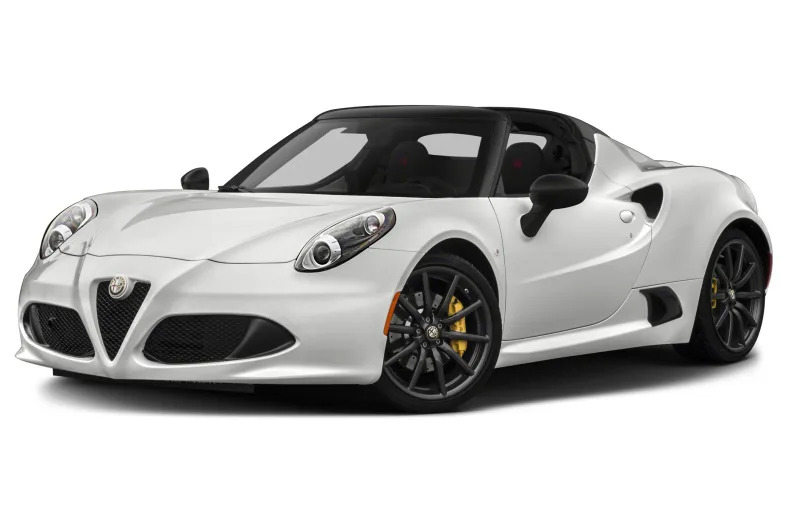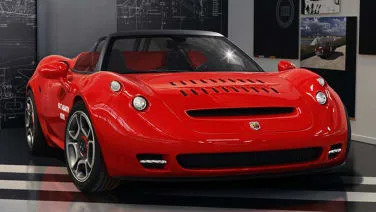2015 Alfa Romeo 4C Spider
Alfa Romeo has been AWOL from the U.S. market for almost two decades, an absence that has produced anticipation and angst in equal measure among the Alfisti. With the arrival of the 4C, that long wait may appear to be at an end, and patience, for those who have actually managed to sustain it, is rewarded. But an asterisk is required here, because America's Alfa drought will be over for only a few. A low-volume, hand-built sports car, the Alfa Romeo 4C represents a thimble of water when a deluge would be more appropriate. There won't be many of these cars, and it will be at least another year before other Alfas, better suited to a broader audience, begin arriving in any quantity.
Still, as a harbinger of Alfas to come, the 4C is a compelling ambassador. Fast, agile, and focused, it's the personification of the sports car ethos, a two-seat tiger that's as happy at an autocross as on the street. Happier, actually. Think small scale Ferrari, and you've got the essence. Plentiful power propelling a raceworthy chassis, packaged in sexy wrappings.
The classic definition of a sports car is a two-seater capable of acquitting itself well on a race track. But to be suitable for ordinary street use, the designers must make compromises aimed at comfort and practicality. The 4C makes fewer compromises than most. As an example, thanks to relatively modest curb weight (2465 pounds), the design team was able to refrain from power assistance for the steering. Suspension tuning conceived to minimize body roll and enhance directional changes will inevitably feel pretty stiff on gnarly pavement, while hard bushings and ultra-stiff structure conspire to transmit road noise into the cabin.
The manual steering effort isn't a real issue, but a creamy ride and quiet interior are simply not part of the package here. On the other hand, for the driver who wants a sports car that thrives on decreasing radius turns, aces autocross events, and is a solid contender for track day trophies, the 4C is as good as it gets. Think maximum partnership between car and driver, the automobile as an extension of the driver's will.
We mentioned hand-built, and that's no exaggeration. Fabricated at the Maserati workshops in Modena, Italy, the chassis is composed of carbon fiber, an expensive and time-consuming procedure that yields a chassis of exceptional rigidity. The engine, which resides behind the cockpit, is a stressed member of the chassis, a design approach called monocoque. Suspension elements are wishbones front, struts rear, and the braking system is robust with big vented discs at all four corners.
The chassis is clad in sheet molding compound (SMC), a synthetic composite, with an injected polymer material used for the fascias and rear spoiler. Windshield and side window glass are thinner by some 10 percent than conventional applications, one of many weight-saving measures.
As an aside, it's interesting to note that the U.S. version of the 4C is 342 pounds heavier than its European counterpart, …
Full Review
Full Review
But an asterisk is required here, because America's Alfa drought will be over for only a few. A low-volume, hand-built sports car, the Alfa Romeo 4C represents a thimble of water when a deluge would be more appropriate. There won't be many of these cars, and it will be at least another year before other Alfas, better suited to a broader audience, begin arriving in any quantity.
Still, as a harbinger of Alfas to come, the 4C is a compelling ambassador. Fast, agile, and focused, it's the personification of the sports car ethos, a two-seat tiger that's as happy at an autocross as on the street. Happier, actually. Think small scale Ferrari, and you've got the essence. Plentiful power propelling a raceworthy chassis, packaged in sexy wrappings.
The classic definition of a sports car is a two-seater capable of acquitting itself well on a race track. But to be suitable for ordinary street use, the designers must make compromises aimed at comfort and practicality. The 4C makes fewer compromises than most. As an example, thanks to relatively modest curb weight (2465 pounds), the design team was able to refrain from power assistance for the steering. Suspension tuning conceived to minimize body roll and enhance directional changes will inevitably feel pretty stiff on gnarly pavement, while hard bushings and ultra-stiff structure conspire to transmit road noise into the cabin.
The manual steering effort isn't a real issue, but a creamy ride and quiet interior are simply not part of the package here. On the other hand, for the driver who wants a sports car that thrives on decreasing radius turns, aces autocross events, and is a solid contender for track day trophies, the 4C is as good as it gets. Think maximum partnership between car and driver, the automobile as an extension of the driver's will.
We mentioned hand-built, and that's no exaggeration. Fabricated at the Maserati workshops in Modena, Italy, the chassis is composed of carbon fiber, an expensive and time-consuming procedure that yields a chassis of exceptional rigidity. The engine, which resides behind the cockpit, is a stressed member of the chassis, a design approach called monocoque. Suspension elements are wishbones front, struts rear, and the braking system is robust with big vented discs at all four corners.
The chassis is clad in sheet molding compound (SMC), a synthetic composite, with an injected polymer material used for the fascias and rear spoiler. Windshield and side window glass are thinner by some 10 percent than conventional applications, one of many weight-saving measures.
As an aside, it's interesting to note that the U.S. version of the 4C is 342 pounds heavier than its European counterpart, …
Hide Full Review
Retail Price
| Engine | 1.7L I-4 |
| MPG | Up to 24 city / 34 highway |
| Seating | 2 Passengers |
| Transmission | 6-spd auto-shift man w/OD |
| Power | 237 @ 6000 rpm |
| Drivetrain | rear-wheel |
| Curb Weight | 2,487 lbs |





